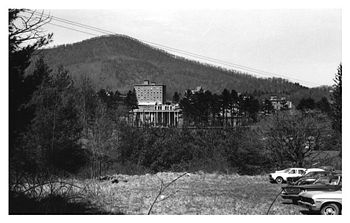Difference between revisions of "Appalachian State University LGBT Life, 1969-1978"
(No difference)
| |
Revision as of 08:54, 16 March 2010
Before Chancellor Herb Wey (1969-1979) officially recognized the Appalachian Gay Awareness Association in 1979, lesbian and gay professors and students had already established informal social networks on campus. The earliest known LGBT campus member was hired in 1929 and actively participated in ASU’s gay subculture during the 1960s. [1] He and gay and bisexual professors socialized with lesbian and gay students while it is rumored that a lesbian professor regularly socialized with her athletes. [1] [2] [3] Many of these professors continued through the 1970s. Mid-century campus members recall a toleration of the lesbian and gay subculture as long as certain lines were not crossed -- they must stay closeted, even behind closed dormroom doors.
Although ASU lacked explicit rules forbidding homosexual behavior, the 1969 men’s resident assistant manual stated that hall counselors should immediately report homosexual cases to the Dean of Men.
This manual validates anecdotes of few former students who recall dorm mates being discovered in compromising situations and shortly after, leaving campus. [2]
Professors lived outside of the ever-watching dorm mother; yet, they too had to be careful. As a retired English professor who arrived at Appalachian in 1967 states, “There are rules and there are rules that can be bent. And you better understand which is which and you’d better not try to bend too hard.” [5] Darrell Rogers (pseudonym), an extremely popular semi-closeted bisexual teacher, committed suicide without leaving a note. [1] [6] Regardless of the root of the conflict, the campus oral tradition perpetuated the belief of anti-gay harassment for many years after his death. Regardless of its truth, this oral lore gave the impression of a negative campus climate and cultivated a climate of fear.
By the early 1970s, gay students began coopting the Methodist student center, the Wesley Foundation, as a social space while lesbian students threw all-girl parties. Watauga College also served as a safe space for lesbian and gay students. [7] [8] [9]
Life shifted during the mid-1970s with the university beginning to publicly address lesbian and gay issues. In 1976, the university’s counseling center began a homosexual counseling group to discuss “everyday problems due to homosexual preference.” [10]
Back to other pages
Suicide at Appalachian State University, 1970
References
- ↑ 1.0 1.1 1.2 Jim Sparrow (pseudonym), Interview with Kathy Staley, 9 April 2007 and 17 April 2007.
- ↑ 2.0 2.1 Nanci Tolbert Nance, Interview with Kathryn Staley, 26 July 2006.
- ↑ Alice Sherman (pseudonym), Interview with Kathryn Staley, 6 April 2006.
- ↑ Handbook for Men’s Residence Hall Staff (Boone, NC: Appalachian State University, 1969), 7.
- ↑ John Higby, Interview with Kathy Staley, 15 December 2006.
- ↑ Patrick Dancy (pseudonym), Interview with Kathy Staley, 9 April 2007 and 17 April 2007.
- ↑ Sharon Price, Interview with Kathy Staley, 10 January 2006.
- ↑ Anna Beaver (pseudonym), Interview with Kathy Staley, 21 July 2006.
- ↑ Max Smith, Interview with Kathy Staley, 3 July 2006.
- ↑ Carol Ferguson, “Counselors Offer Discussion on Homosexual Problems,” The Appalachian, 4 February 1975, 4.
|| | | | | | | | |
